The Boxer’s Disease

by Joe Calvey
jcalvey@aol.com
photographs available at zenfolio.com/joecalvey
Welterweight Oscar Diaz nearly died from head trauma inflicted during an ESPN 2008 prize fight in San Antonio. Two months after emergency brain surgery Diaz emerged from a coma. More months passed before being released from the hospital 225 days after the fight. Upon his release his neurosurgeon, Dr. David Jimenez was quoted in USA Today saying he was "confident" Diaz would "someday walk and talk again".

On the two year anniversary of the fight San Antonio Express News writer John Whistler (above right with Julio Cesar Chavez, Sr.) wrote "Progress has been slow. Doctors said he eventually was able to sit up, squeeze a ball and was starting to eat some foods, such as pudding…"
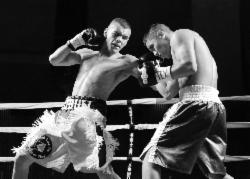
San Antonio has a young prize fighter in high school Javier Rodriguez (above left) training out of the city owned San Fernando Gym. His father, Javier Sr. worries whenever Javier steps into the ring. "Javier is a straight A student. His hero was San Antonio’s late World Champion Robert Quiroga. Javier’s bedroom is covered with posters of Robert, he has dreamed of being a boxer for as long as I can remember."
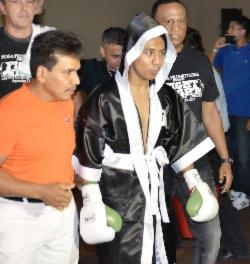
3 days after turning eighteen with dual video screens showing training highlights Luis Lopez (above, right) of Cleveland, TX wearing a black satin robe and matching trunks walked to the ring for his pro debut at the Cleveland Civic Center. Lopez was greeted by a vocal packed house of locals, friends and family. But that didn't take away the look of concern that spread over both fahter and son's face as they looked at the ambulance crew and stretcher that was ringside.
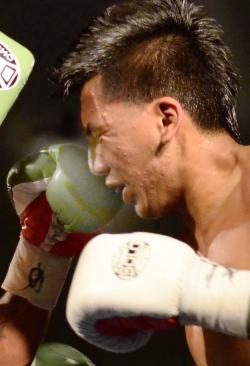
Lopez had an amateur career record of 20-2 and won a national title. Lopez is managed and promoted by Ramon Sosa, a former boxer. Sosa is president of Texas based Sosa Promotions. Lopez won a tough four round decision over Richard Munoz who was every bit as tough and committed to winning.
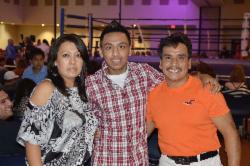
Lopez’s father and mother support their son. Theirs is the classic story of immigrants earning the American dream. Lopez hopes to eventually enroll at Kingwood Community College. Meanwhile civic leaders believe this fight will help boost Cleveland’s image after the community was rocked by the rape of an 11 year old girl by 20 adult and adolescent males. Lopez, a 122 pound bantamweight has a lot of weight on his shoulders.
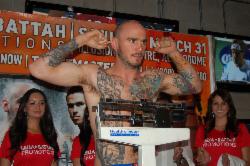
Boxing in Texas is a state regulated sport ostensibly more so for the protection of the combatants than for the taxes it collects. Any promoter will tell you there is no shortage of fees collected by the state or expenses related to compliance including overseeing weigh ins (pictured above Kelly Pavlik). Regulation dictates that there be two ringside physicians in attendance at all prize fights. The technical zone around the ring is a restricted area closed to fight fans. Inside this area no alcohol is allowed and promoters are fined heavily for any violation.

Located inside the technical zone must be a certified ambulance crew with rescue equipment and stretcher. An ambulance is located outside at the nearest point to the ring. All fighter’s are observed getting their hands wrapped and once the gloves are laced up they are marked by an inspector of the Texas Department of Regulation and Licensing. To administer the rules and conduct a fight a TDLR team of 15 officials is not uncommon.
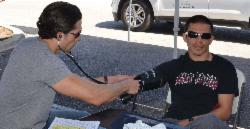
Texas allows 17 year olds to fight professionally and requires of fighters a comprehensive medical exam, blood work to prove they are free of several Hepatitis and HIV viruses, an eye exam and $20. Applicants over 36 years of age must also submit results from an EEG brain activity test and an EKG heart test. Promoters must provide combatants a $50,000 medical insurance policy and a $100,000 death policy for injuries suffered during their event. In today’s economy that may be too little. (pictured above Dr. Luis Chapa, left, boxer Rafael Casias, right)
Throughout the sports world discussion revolves around brain trauma. We now know that repeated blows to the head and repeated concussions have the potential to affect an athlete for life. The NFL has participated in the costs associated with retired players care. Boxers have no such long term assistance.
Eric Meyer, a health food salesman from San Antonio recently posted on Facebook "any parent who allow their 16 year old to have his head bashed in maybe ought to spend a few years in prison having their own head bashed in." Stating he’d tell Rodriguez’s parents they need to have the consequences of their decision explained to them. On Facebook Mr. Meyer posted pictures of his son’s at a martial arts studio. Clearly Mr. Meyer’s opinion of boxing aligns with the outer fringe of the anti boxing crowd.
While the state seeks to protect fighters more needs to be done regarding long term health care lest elitist opinions like Mr. Meyer’s take root. Pugilistic dementia is a long term chronic degenerative disease that requires long term care. Two ways to provide for that long term care are either by state mandate or voluntary participation between the boxer and promoter to fund it.
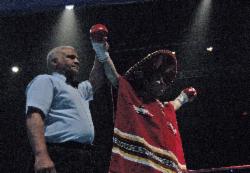
Americans love the rags to riches story. Boxing is filled with both. The opportunity to earn vast riches at the top national and international level (pictured above left referee Will Esperon and boxer Steven Hall) is a very seductive dream that comes in multiple weight classes. Youth though is cursed with the feeling of invincibility. Wilfred Benítez became a World Champion at 17 and was broken at 38 living on charity in his native Puerto Rico. The once great champion suffers and will never recover from the boxer’s disease.
No other sport provides the opportunities boxing offers. Now is the time boxing needs to provide for the fighters after the crowd has gone home. Oscar and every ring warrior deserve it.
Copyright 2013 Joseph J. Calvey, Sr. All rights reserved. This article may not be reproduced in whole or part without the written permission of the author